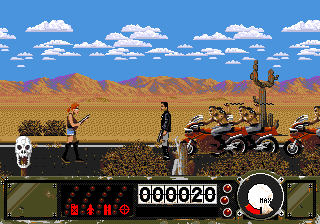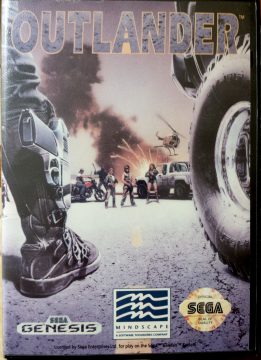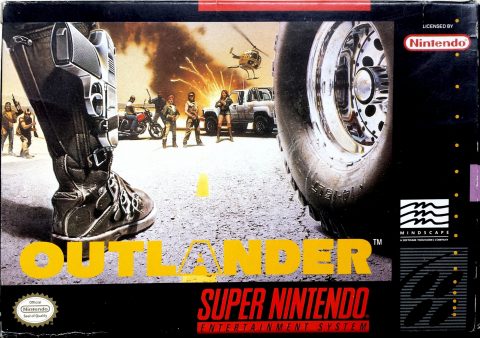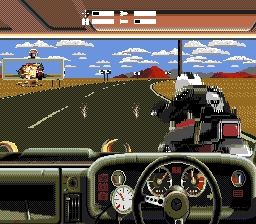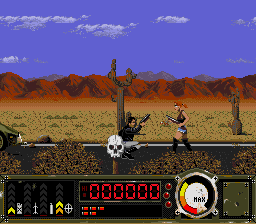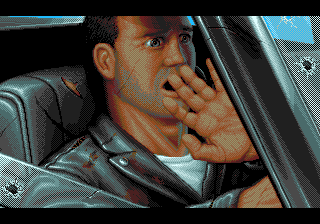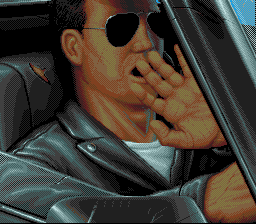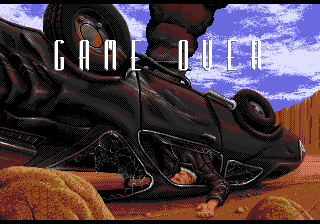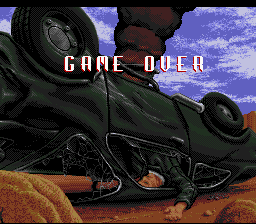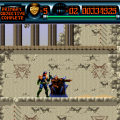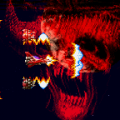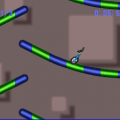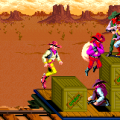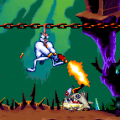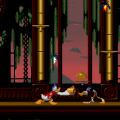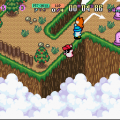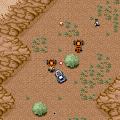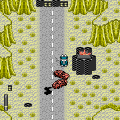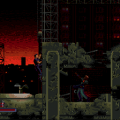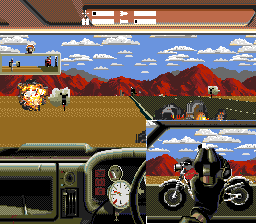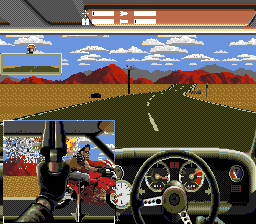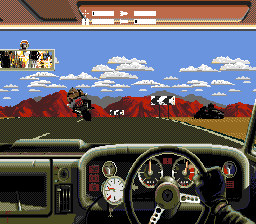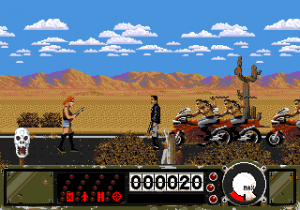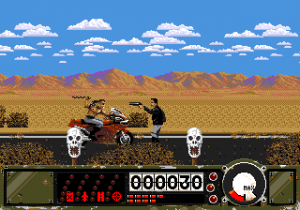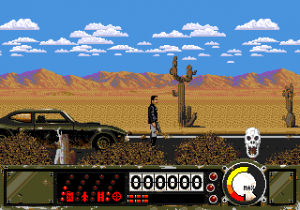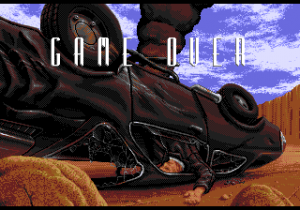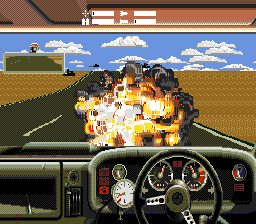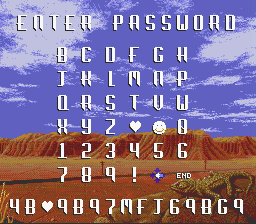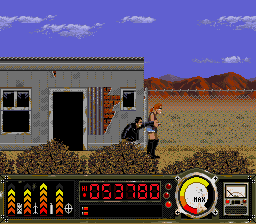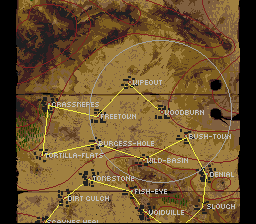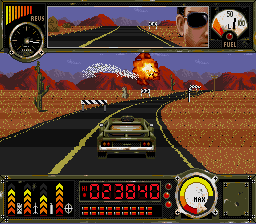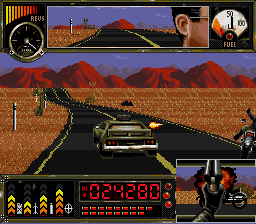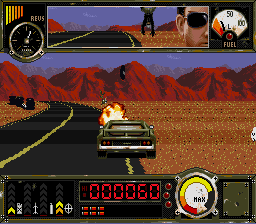As the Sega Genesis’ popularity grew in the US in the early 90s, Mindscape tried their hand at a Mad Max game again. Ditching the exploration, players would now drive from a first person view down a windy but linear road, able to get out of the car at any time to explore a basic side scrolling level in which one can shoot marauders and collect numerous helpful items like food and replacement tires. Graphics are of course much better than the NES take, and while it can get choppy, the game has a decent amount of action with lots of high speed collisions as you ram into and run over various bikers.
In an especially inspired touch, when a motorcycle tries to pull up next to you a view of your side window pops up in the left or right corner, allowing you to cleanly blow an oncoming biker’s head off with your shotgun while driving and firing the car’s front mounted machineguns at the same time. It’s very simple, but you can tell Mindscape learned their lesson from the NES Mad Max game and made a solid effort here. It also helped that Mindscape got a more talented team to develop the game, with many members still working in the game industry today.
Most notable is probably Ken George, who started out doing Q&A for EA, but after producing Outlander would go on to produce several games for Sony’s 989 Studios throughout the 90s. Sound effects were handled by Mark Knight, who would has since worked on audio design for Codemasters’ F1 series. Interestingly, much of the team would end up working together on an eclectic series of games like Warhammer: Shadow of the Horned Rat, CyberSpeed, and installments in the Fable series as well as several Harry Potter games. Finally, one of the designers, Steve Leney, was previously responsible for the graphics found in Amiga games like Moonstone, D/Generation, and the particularly beautiful Darkmere. Unfortunately what Mindscape learned in game publishing, they forgot in licensing ability, and failed to successfully renew the Mad Max license itself. Enter the same game, under a new title, Outlander.
Despite the removal of direct references to the Mad Max series, this game impressively looks and plays like something closer what we see in the opening of Mad Max 2 than anything in Mindscape’s half-baked NES game. All of the enemies are clearly based on characters seen in Mad Max 2 even after the game’s last minute identity crisis. While the more linear layout is initially disappointing, the focus on fast driving and sudden violence not bringing the game to a screeching halt are welcome improvements. What does bring the game to screeching halt, however, are the portions where you get out of your vehicle to walk across strips of wasteland or hostile towns to pillage. The graphics are nice, and “Max’s” sprite is relatively large with decent enough animation, but there is almost no enemy variety. In addition, while you of course have a shotgun, ammo is much more limited here, so the best strategy tends to be crouching and just punching enemies in the legs repeatedly until they go away. Max can also “jump,” but this is more of a short hop forward, useful only to avoid the incoming projectiles bikers will toss at you while exploring outside of towns.
That distinction of being in or outside of a town is important, as in this game, you can pull over on the side of the road any time you want and the game will give you a short but dangerous stage to fight through. This is only recommended if you’re very desperate, as the bikers have a bit of an advantage over you just walking around and the rewards are slim. However, as you approach actual towns you’ll see a sign and your turn signal (or your emergency lights in the SNES version) will automatically activate. Following the cue and pulling over at these points will let you enter actual remnants of civilization. These areas are longer, but offer the fuel, food and car parts you’ll need to make it to the end of a very long trip. You could skip these small towns if you want to make the game more challenging, though the game’s length is an asset here as the difficulty increases very steadily as you play, so the challenge feels consistent and natural.
While the game is monotonous, and would take about three or four hours to complete, Outlander is kind enough to give you a password at every fourth town you stop at. You can earn continues as your score increases too. You’ll need plenty of both as you crisscross the game’s map repeatedly (of course in this COMPLETELY LINEAR game Mindscape lets you view a map at any time) to go through twenty-four towns. The game’s difficulty increases gradually, but with so much road to battle across it will become extremely challenging towards the end.
Mindscape couldn’t use the exact story from any of the Mad Max films, so things were made a little more convoluted. According to the manual, the game takes place 108 years after a nuclear war, in a world where our water supply is vanishing as the oceans very slowly freeze over. But then “our greatest remaining scientist” found a way to create an unlimited source of water. He then travels the world by plane delivering the knowledge of his water synthesis process to every nation. But then:
His plane was shot down over the Wasteland of Australia, the broadest and driest desert in the world. The greedy inhabitants, led by the insane Duster, planned to capture Dr. Beaumont and the blueprints for his machine before any other country had a chance to copy it. By controlling the only source of water, they planned to control the world, and keep a stranglehold on every nation and citizen in it.
In a last-ditch effort to rescue the doctor and his lifesaving plan, the desperate remnants of the United Nations hired a mercenary soldier, one who knew the Wasteland, but had crossed over to the Outlands. He was an old friend of Duster’s, and perhaps understood his madness and desire for power more than Duster himself did. He was the only one who could stand a chance against the toughened inhabitants of the inland desert. His old comrades in the Wasteland call him simply, the Outlander. The rest of the world calls him our only hope.
None of this background information appears in the game. You just go from town to town blasting people that look like they’re from a Mad Max movie until you confront Duster at the end. He stands out by being a nine foot tall cyborg, but isn’t particularly difficult to defeat. When you overcome him, you finally get to meet Dr. Beaumont. A brief dialogue happens where it’s clear that he’s gone mad. As the Outlander clarifies for us: “Oh no! His ordeal has sent him insane.” He then offers to take the doctor home. This is pretty much played for laughs and is completely out of nowhere compared to the barren, hostile nature of the rest of the game. I can imagine players being frustrated that after enduring the tedium of the final areas, the mission was for nothing and humanity will continue to be doomed.
Outlander was quickly forgotten when it was released on the Sega Genesis in 1992, but has a gained a small cult following over the years as both people who remember it as well as new players have come to appreciate its ambition and intense pacing. The game hilariously doesn’t even let you go in reverse, making it possible to miss towns or return to your car only to be stuck in a rock, forced to slowly drive against it until the game decides you can slide through it. Everything is focused on speeding forward and destroying everyone.
Having the final confrontation against Duster take the form of one of the regular side scrolling levels, and having Duster himself behave and fight like every other enemy in the game despite his imposing size feels like a huge misstep. It’s one of the most anti-climatic bosses of any game because of this. While more durable enemies appear in higher numbers as these stages go on, they all work the exact same way. It would have made for a much better final confrontation if this fight took place in on the road with the player racing and shooting at a unique vehicle. The game teases this, as one runs into a unique truck at the end of the game, but it barely puts up a fight. As soon as it’s defeated what could have been an opportunity to introduce a twist into the driving segments gives way to another boring and identical chance to slowly walk to the right punching people in the groin.
One year later, Mindscape would release Outlander on the SNES. Nintendo Power was not particularly impressed with the game, especially due to the tedious on foot sections, though they enjoyed the driving action. A few changes were made for the SNES release, most of which are improvements over the Genesis version. Besides more colorful graphics and much higher quality music (of which there are four songs in Outlander, that’s FOUR TIMES THE MUSIC that was in Mad Max!), the biggest change is that you view your car from the third person like in F-Zero.
This is welcome since your mirror is still at the top of the screen so you get a much better feel for how close your enemies are to you. While it costs some energy like in the Genesis game it, it makes it much easier to destroy bikers by simply ramming into them when desperate. It allows for some extra details too: if you see a biker approaching from behind, it’s easier to get in front of them and brake, causing their bike to explode while the driver flips forward and hits the pavement in front of your vehicle, immediately getting run over as you resume your journey. You can also do this to oncoming traffic, catching a view of the thrown driver in your rear view mirror without skipping a beat. These actions are possible on the Genesis game, but much easier to do on the SNES, and as gratuitous as they are any extra detail in such a monotonously structured game is welcome.
More importantly though, in the Genesis game, firing your car’s machine guns and firing your shotgun out the side windows were done with the same button. This would often cause you to waste ammunition from one weapon while trying to hit an enemy with the other. On the SNES controller, the triggers are used to fire your shotgun left or right, while the B button fires your car’s machineguns forward, fixing this. They even added the ability to drive in reverse for those times where you’re stuck in front of an obstacle so you don’t have to take additional damage as you right yourself. The side scrolling areas, unfortunately, are identical to their Genesis counterparts. The graphics and sound are superior but it’s barely an improvement when you have to go through twenty-four versions of the same three or four areas.
There are two changes to the game’s detriment. One is that an entire enemy type, the jeeps seen in later levels of the Genesis game, are gone. They’re replaced with many more road blocks for you to crash into than were ever in the Genesis game. The other is that your vehicle takes much more damage from collisions compared to the Genesis game. So despite the control improvements it’s much more difficult to drive aggressively and enjoy the game’s strengths. While the SNES version is generally preferred for its superior graphics and sound many fans stick with the Genesis version for being more tightly balanced.
While the side scrolling segments in Outlander start out fun and interesting due to the variety of items you can get but quickly become torturous, it’s still worth a play to appreciate the length of the track and number of areas players are expected to overcome for such a downer ending. While not bloody, it’s also enjoyable for its intense action with vehicles constantly exploding and bodies flying everywhere as you get further across the map. Unfortunately the game has never been re-released, and only the SNES version was released outside of the US, making it difficult to come across for some gamers. Still, the unusual structure for an early 90s game and fast brutality of the driving segments make it worth a look.
